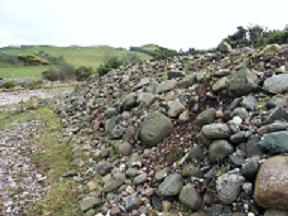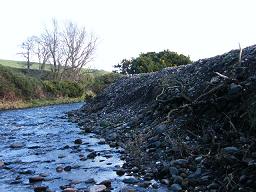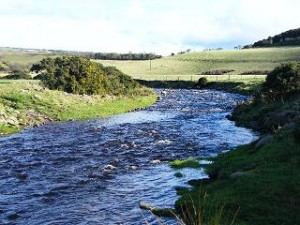Development Plan
In 1978 about one mile of the river Carey above Ballyvoy was dredged (presumably for drainage purposes)
In today’s more environmentally aware world it is unlikely that such a project would have got planning permission.
A huge amount of damage was done to spawning and nursery habitat. I remember watching good numbers of salmon spawning in 1977 before this was all dredged and seeing many redds in the gravel. The pictures below will illustrate that there are now no resting places for spawning salmon in this section of the river and about 1 mile of the river is severely degraded in its ability to support Atlantic salmon. Salmon need various river habitats: Spawning gravels, areas for security and cover near spawning time, holding pools before spawning time, and habitat that will allow good growth and space for juvenile development. Specifically spawning areas with appropriate sized stable gravels and flows ( found in glides and riffles) and nursery areas for growth. The drainage scheme obliterated all of these habitats and now this part of the river is severely compromised in its ability to produce Atlantic salmon. The nursery habitat remains with the attendant spawning habitat nor pools to accomodate adult fish at spawning time. In drought and normal flow conditions there are no areas for juvenile fish, parr and smolts to survive. The impact of the sun on such a degraded habitat where is no water depth will have a detrimental effect on the whole river downstream. Additionally floods and spates on such a degraded river bed can cause excessive movements of gravel downstream. The increased water velocity during spates compound s gravel movements further.
Salmon coming home project
The key aim of the upper Carey, Salmon coming home project, is to restore some depth to the river channel and create a series of pools, glides and riffles providing appropriate near spawning time cover, and increased depth for juvenile development. The pictures below were taken at a time of snow melt when the river was elevated to a good height. Clearly the river depth and the natural pool glide structure of the river is destroyed. For almost a mile the river could be waded easily with a pair of wellingtons at any point.
The evidence for all the dredging operations is highly visible. Creating a series of groins and planting a few willows or alders would be a cost effective way to restore the habitat. A plan will be developed to ensure that this restoration process develops using the natural flow of the water. A key aim is to restore the habitat of this area of the river towards it previous state, as a conservation/ sanctuary for spawning salmon and a nursery area for growing juveniles.
Issues:
Scroll down for more pictures
| Illustrated stages of salmon’s life cycle.
Different habitats are required at each stage of the lifecycle. For example adult salmon (and trout) need water ventilated gravels suitable for laying eggs in Redds in the autumn and which are stable enough to hold eggs until they hatch. Good quality clean non polluted oxygenated water to facilitate good growth of alvein to fry in the shelter of gravel and river bed. As the fry develop into parr and get larger they require more water, riffles and pools, for growth and security. Stable banks that provide security and which encourage flora and fauna will help good growth. Juvenile salmon parr after 2 to 3 years change physiologically into smolts, move downstream and migrate out to sea to feed and grow rapidly. When they return as adults 1 to 2 years later (or more) they migrate upstream again and wait for spawning time. (Late Autumn /Early Winter) Resting and hiding places are required for adult as they wait for spawning time which requires a sufficient depth of water and security particularly for any early running fish. These fish are particularly valuable and need to be given all change to develop into a sustainable run A stable Environment that accommodates safety and security during floods and droughts is essential. If there are good numbers of salmon spawning in the autumn, the runs of the future runs are secured and nutrients are transferred from the ocean to stream to provide useful organic matter and natural sustainability. |
 Stones dredged to river bank is a problem for habitat
Stones dredged to river bank is a problem for habitat
| No Depth, Stream not contained, and dredging spoil heap | What a mess! | Looks OK but no depth anywhere! | Before dredging this was a great pool. Fish could take cover |
| This should go back into the river | No Nursery area | No hiding place! | Need to deepen and keep banks narrow! | |
| No depth anywhere | Goes on for a mile | |||
| Potential | First stopping off/ holding water? | How many parr could this produce? | Plenty of material | Wouldn’t take much! |



